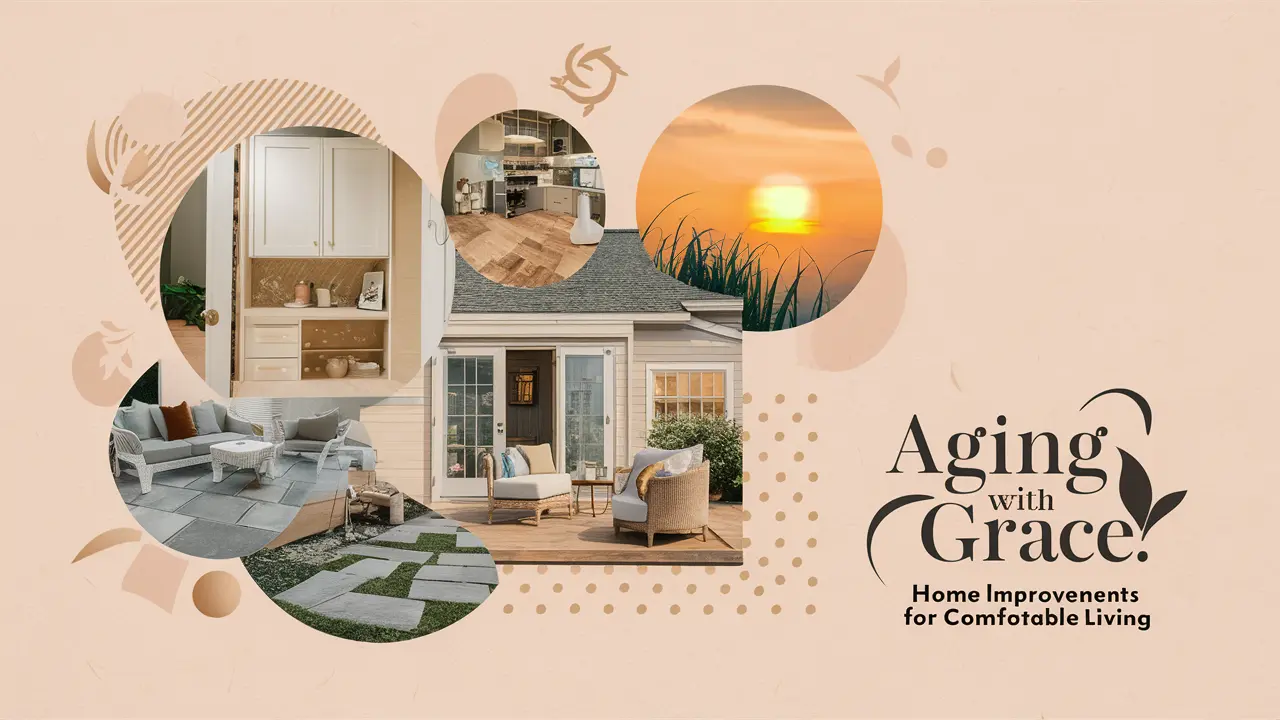Aging with Grace: Home Improvements for Comfortable Living

Aging is a natural part of life, and as we grow older, our needs and priorities change. One of the most important aspects of aging gracefully is creating a home environment that supports safety, comfort, and independence. Home improvements tailored to aging individuals can make daily life easier and more enjoyable while promoting long-term well-being. In this article, we will explore practical home improvements that help seniors age with grace.
1. Focus on Accessibility
Accessibility is a key consideration for aging individuals. Making your home easier to navigate reduces the risk of accidents and enhances independence.
- Wider Doorways: Widen doorways to accommodate wheelchairs or walkers. A doorway width of 32-36 inches is ideal.
- Step-Free Entryways: Install ramps or eliminate steps at entrances for smooth access.
- Lever-Style Door Handles: Replace traditional knobs with lever handles, which are easier to operate for those with arthritis.
- Non-Slip Flooring: Use slip-resistant materials like rubber, cork, or textured vinyl to prevent falls.
By prioritizing these upgrades, seniors can enjoy greater mobility and independence in their daily lives.
2. Create a Safer Bathroom
The bathroom is often a high-risk area for slips and falls. Simple modifications can make it much safer.
- Grab Bars: Install grab bars near the toilet and shower for support.
- Walk-In Showers or Tubs: Replace traditional bathtubs with walk-in models to eliminate the need to step over high edges.
- Handheld Showerheads: Use handheld showerheads for better control during bathing.
- Raised Toilets: Install raised toilet seats to make sitting and standing easier.
- Non-Slip Mats: Place non-slip mats in the shower and on the bathroom floor.
These changes ensure that the bathroom remains a secure and accessible space for aging individuals.
3. Improve Lighting
Good lighting is essential for safety and visibility, especially as vision changes with age.
- Bright LED Bulbs: Use energy-efficient LED bulbs that provide bright, even lighting.
- Motion-Sensor Lights: Install motion-sensor lights in hallways, bathrooms, and entryways to reduce the risk of stumbling in the dark.
- Task Lighting: Add task lighting in areas like the kitchen, reading corners, and bathrooms.
- Dimmers: Install dimmer switches to adjust lighting levels according to needs and preferences.
Enhanced lighting can significantly reduce the risk of accidents and create a more comfortable living environment.
4. Adapt the Kitchen
The kitchen should be a functional and safe space, especially for seniors who enjoy cooking.
- Pull-Out Shelves: Use pull-out shelves in cabinets to reduce bending and reaching.
- Easy-to-Use Faucets: Install single-lever faucets or touchless models for convenience.
- Lower Countertops: Lower countertop sections to allow for seated food preparation.
- Induction Cooktops: Replace traditional stoves with induction cooktops, which are safer because they do not produce open flames.
- Bright Lighting: Ensure the kitchen is well-lit to reduce eye strain and improve visibility.
By making these adjustments, seniors can continue to enjoy cooking and meal preparation with ease and safety.
5. Make Stairs Safer
Stairs can become challenging to navigate as mobility decreases. Modifications can reduce risks.
- Handrails on Both Sides: Install sturdy handrails on both sides of the staircase.
- Non-Slip Treads: Add non-slip strips to each step for better grip.
- Stair Lifts: Consider installing a stair lift for those who find stairs difficult.
- Clear Pathways: Keep stairs free of clutter to avoid tripping hazards.
Safe stairways contribute to greater confidence and independence for aging homeowners.
6. Enhance the Living Space
The living area should be comfortable, accessible, and conducive to relaxation.
- Declutter: Remove unnecessary furniture and items to create open spaces.
- Comfortable Seating: Choose chairs and sofas with firm cushions and armrests for easier sitting and standing.
- Low-Pile Carpets: Replace thick carpets with low-pile options or area rugs with non-slip backing.
- Reachable Storage: Place frequently used items within easy reach to minimize stretching or climbing.
A thoughtfully designed living area fosters relaxation and safety for seniors.
7. Upgrade the Bedroom
A well-designed bedroom promotes restful sleep and convenience.
- Adjustable Beds: Consider adjustable beds that allow for different sleeping positions.
- Bed Rails: Install bed rails for added support when getting in and out of bed.
- Closet Accessibility: Use sliding closet doors and lower hanging rods for easier access to clothing.
- Nightlights: Place nightlights near the bed to provide soft lighting for nighttime movement.
With these changes, the bedroom can remain a peaceful and functional retreat.
8. Integrate Smart Technology
Smart home devices can enhance convenience and security for seniors.
- Smart Thermostats: Use smart thermostats to maintain a comfortable temperature with ease.
- Voice-Controlled Devices: Install devices like Amazon Echo or Google Nest for hands-free control of lights, appliances, and more.
- Video Doorbells: Add video doorbells to see who is at the door without opening it.
- Medication Reminders: Use smart pill dispensers with alerts to ensure medications are taken on time.
- Emergency Alerts: Install wearable emergency devices that allow for quick communication in case of a fall or other emergencies.
Embracing technology can simplify daily tasks and provide peace of mind for seniors and their families.
9. Focus on Outdoor Spaces
Outdoor areas should be accessible and enjoyable for relaxation or light activities.
- Smooth Pathways: Ensure walkways are even and free of cracks or obstacles.
- Raised Garden Beds: Use raised garden beds for easier gardening without bending or kneeling.
- Motion-Sensor Lights: Place motion-sensor lights around the yard for safety at night.
- Secure Railings: Install railings on porches and patios for added stability.
Spending time outdoors can enhance physical and mental well-being, making these changes especially valuable.
10. Plan for the Future
It’s wise to think ahead and make modifications that will continue to meet your needs as you age.
- First-Floor Living: Consider creating a bedroom and bathroom on the first floor to minimize the need for stairs.
- Flexible Spaces: Design spaces that can be adapted for future mobility aids like wheelchairs.
- Universal Design: Incorporate universal design principles that accommodate individuals of all abilities.
- Professional Consultation: Hire certified aging-in-place specialists (CAPS) to assess your home and recommend improvements.
Planning ahead ensures that your home remains a supportive environment for years to come.
Conclusion
Aging with grace is about embracing change and making thoughtful adjustments to your home. By focusing on accessibility, safety, and comfort, you can create a living environment that supports independence and enhances quality of life. Whether you’re planning for yourself or a loved one, these home improvements can make all the difference in ensuring a happy, healthy, and graceful aging process.
By taking the time to implement these home improvements, seniors can enjoy a safe, comfortable, and independent lifestyle. Aging with grace isn’t just about adapting to life’s changes; it’s about thriving in every stage of life. Through these thoughtful modifications, homes can become sanctuaries that support health, happiness, and dignity throughout the aging journey.
